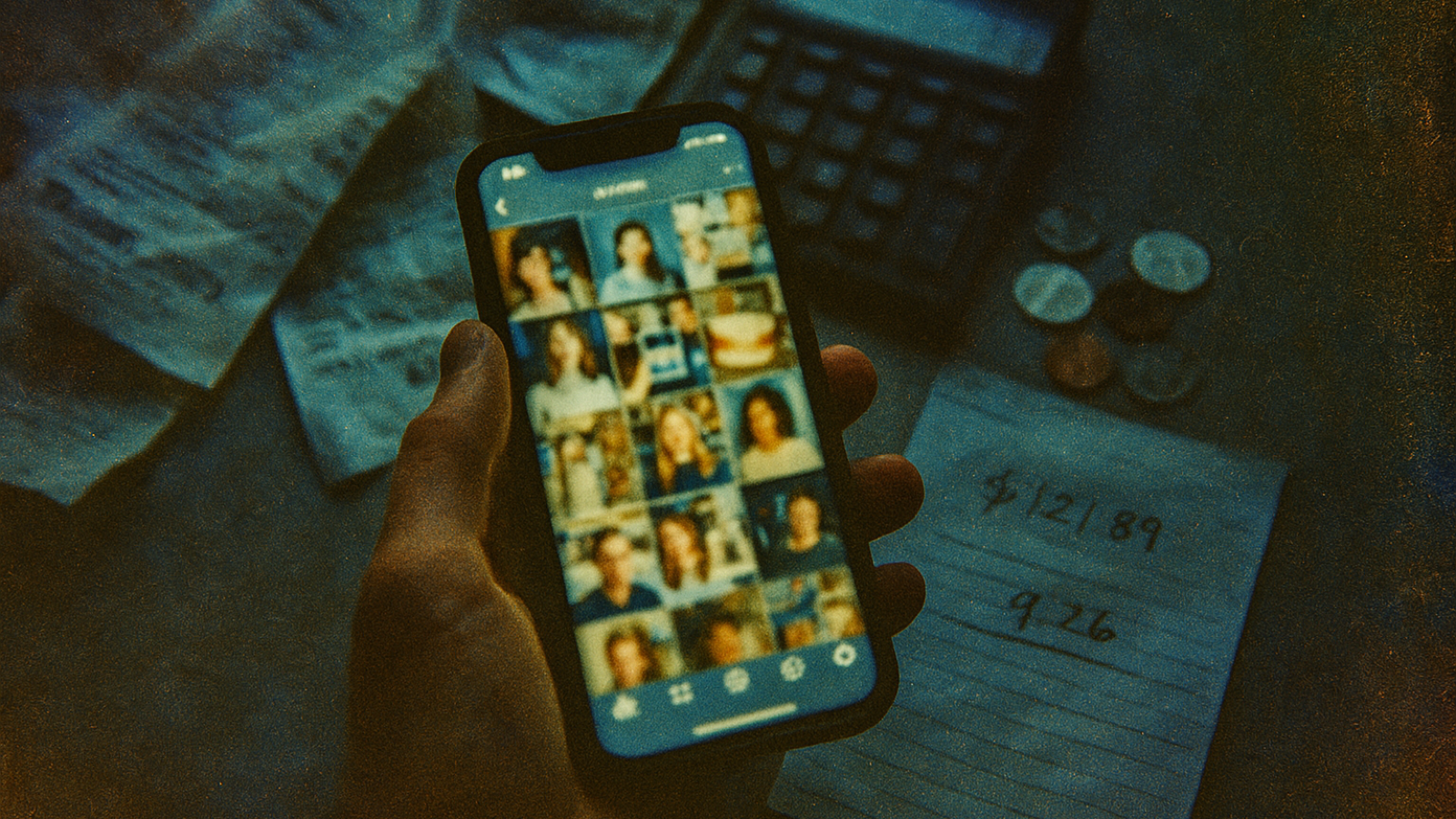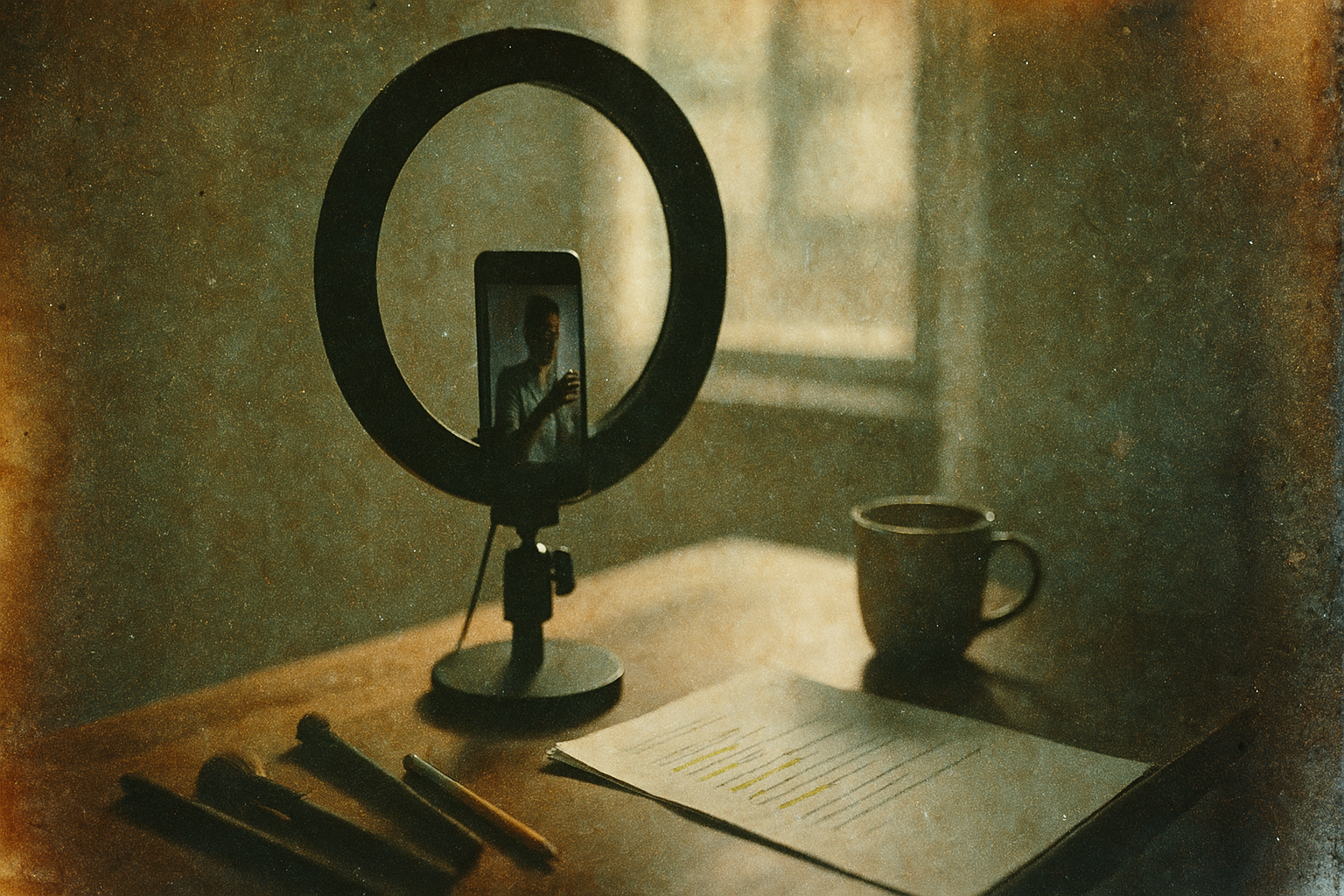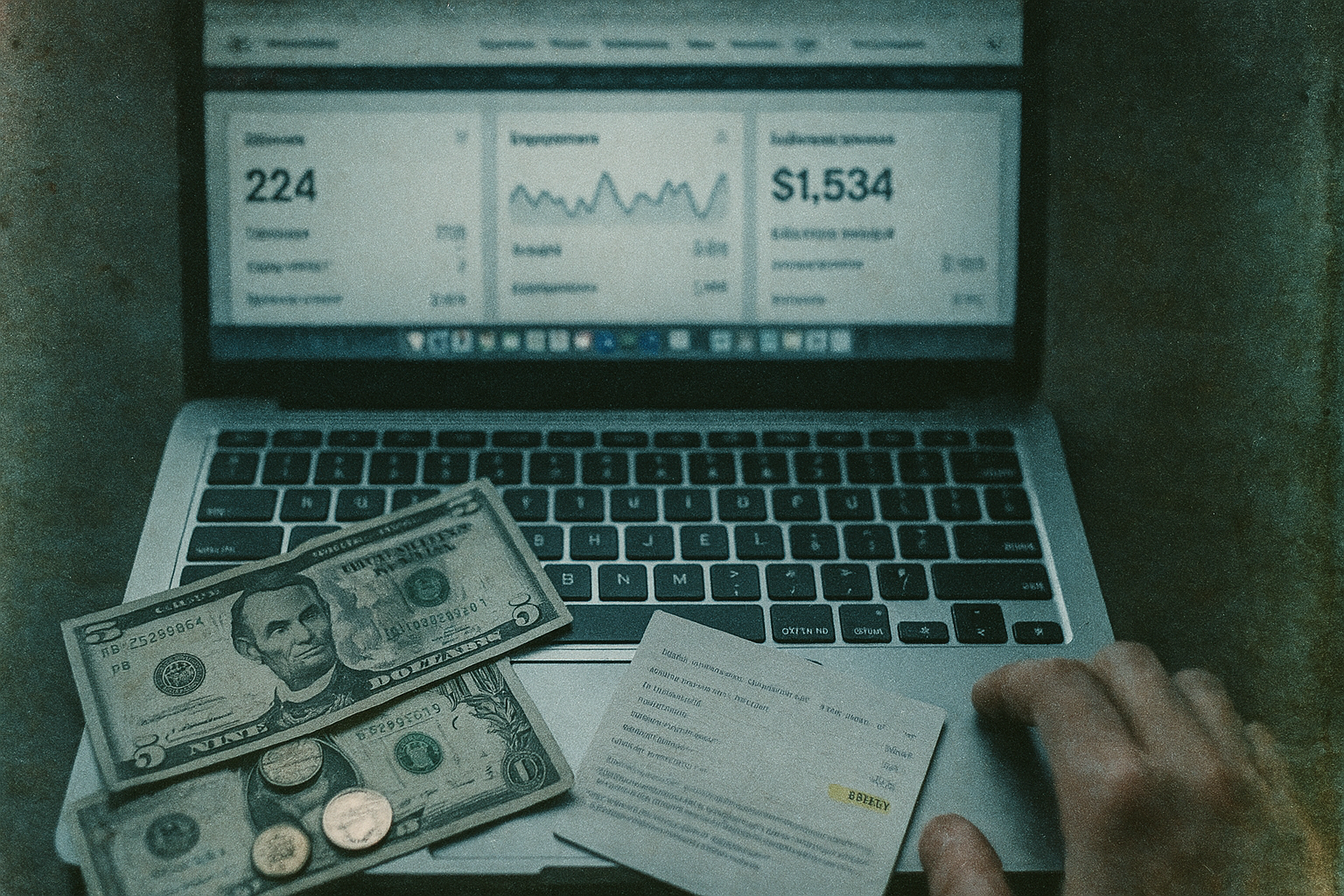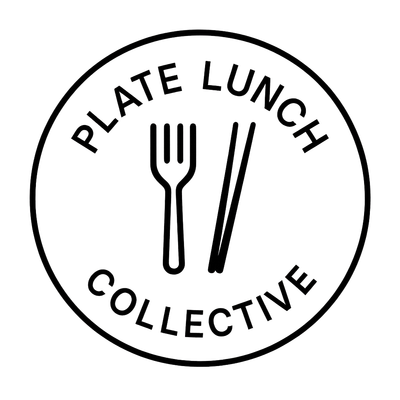The Impossible Math of Authentic Trust: A Business Owner's Guide to the Creator Economy

You open Instagram and there's someone, maybe 47,000 followers, maybe 180,000, holding a water bottle with studied casualness, talking about hydration like it's a spiritual practice. The lighting is good. The kitchen behind them costs more than your car. They say "obsessed" twice in thirty seconds. You know this is an ad. They know you know. The bottle company knows you both know. And yet here we are, all of us, pretending this moment of manufactured authenticity might convince you to spend $38 on a bottle that holds water.
The global creator economy will hit $480 billion by 2027. That's real money chasing something fundamentally strange: the monetization of trust at scale, the industrialization of friendship, the conversion of parasocial relationship into purchase behavior.
Sixty percent of consumers will engage with a brand if the right creator recommends it. Eighty-six percent have actually bought something because an influencer told them to. The average return is $5.78 for every dollar spent. Brands that invest 42% of their social budgets in creator partnerships see returns that traditional advertising can't touch.
More than half of all creators earn less than $15,000 a year. There are 207 million people making content, and the money concentrates at the top while everyone else grinds against what the data calls "the monetization barrier."
The Platforms Are Not Neutral
A creator with 48,000 TikTok followers posts a video about a product, and 30.1% of the people who see it click the link, which is such an absurdly high number that it almost doesn't make sense until you remember that TikTok's algorithm is essentially a slot machine designed by people who understand dopamine better than you understand your own attention span. That same creator on Instagram gets 1.8%. Same person, same product, same level of trust with their audience, but one platform delivers 1,570% more link clicks because the algorithm decided it should.
YouTube Shorts serves 2 billion users a month, and a study tracked 685,842 videos to understand what the algorithm actually does with them, and what it does is consistently, methodically, almost ruthlessly drift away from whatever you started watching toward entertainment content, regardless of what you engage with or how long you watch, so you could spend three minutes absorbed in something about climate policy and the next video will be someone dancing or a cat doing something improbable because the system has decided that engagement metrics (views, likes, comments, the quick hit of validation) matter more than whether the content has any relationship to what you were just interested in, and it prefers joyful or neutral emotional content because complicated feelings make people stop scrolling.
Instagram just started letting search engines index public content from professional accounts, but only if you opt in, and never Stories, which disappear anyway, so the format that generates the most daily engagement, the thing people actually use, remains invisible to the rest of the internet. TikTok's research API gives academics access to a curated subset of platform data, which means even the people studying this are working with incomplete information, trying to understand a system while only seeing the parts the system wants them to see, which is roughly like trying to understand the ocean by looking at a glass of salt water.
Instagram built its creator economy on the fact that 57% of all brand partnerships happen there, then quietly adjusted the algorithm so your followers don't see your posts unless you pay to boost them, which is the kind of move that would be called a bait-and-switch in any other industry but here it's just called Thursday.
What Actually Converts
The traditional "link in bio" approach converts at roughly 1.08%, which means that out of every hundred people who see your post and decide they're interested enough to take action, ninety-nine of them will get lost somewhere in the process of remembering your post exists, opening your profile, hunting for the link among whatever else you've got stacked in there, clicking it, waiting for the page to load, and then making an actual decision about whether they want to buy something. You post, they see it, they remember, they open your profile, they find the link, they click, they land on the page, they scroll, they decide. Each moment is a place to lose them, and most of the time you do.
Automated clickable DMs work better, though the mechanism is almost comically simple when you think about it: someone comments on your post, a bot immediately sends them a message with a link, they click, they're on the product page. Friction drops. The personalization matters even though it's automated, even though they probably know a bot sent it, even though the whole interaction is manufactured by someone who set up a trigger and walked away. It still works better than making them hunt.
Shoppable posts with user-generated content convert 80% more than posts without it, which suggests that people trust other people more than they trust brands, even when they know the other people are being paid by the brands. YouTube end screens and cards lift conversions 45% for brands using creator content instead of their own polished marketing materials. TikTok users make immediate purchases 40% of the time after discovering products on the platform, jumping to 50% during live videos when there's a person right there talking to them in real time, creating the illusion of urgency and scarcity and personal connection even though thousands of other people are watching the exact same broadcast.
The Authenticity Problem
Sixty-three percent of consumers trust influencer recommendations more than traditional advertising, which is either a profound statement about the death of institutional credibility or a damning indictment of how good we've become at manufacturing intimacy at scale, or possibly both at once. That trust sits at the center of everything. Without it, none of this works, which is why the FTC revised its endorsement guides in 2023, requiring creators to make clear and conspicuous disclosures of their relationships with brands, because the temptation to deceive is constant and the line between authentic recommendation and paid promotion has become so blurred that most people can't tell where one ends and the other begins, and maybe that's the point.
A 2025 study surveyed 500 social media users and found that credibility and perceived authenticity predict consumer behavior more strongly than any other factors, which sounds obvious until you remember that authenticity is exactly the thing that becomes impossible the moment you try to manufacture it at scale. Trust partially mediates the relationship between advertising effectiveness and actual purchase behavior, which is a technical way of saying that if people think you're lying, they won't buy, but if they think you're telling the truth even when you're being paid to say something, they might.
The question nobody has answered is how to manufacture authenticity at scale, how to industrialize trust, how to make something feel real when everyone involved knows it's a transaction. High-ROI brands give creators creative freedom, which sounds like marketing speak until you see the data. Forty percent prioritize creators for their vision rather than their follower count. Approvals happen quickly. Long-term growth matters more than extracting maximum value from each transaction, which is the kind of patient thinking that runs counter to every quarterly earnings call but apparently works if you can afford to wait.
Creators are nearly four times more likely to continue partnerships when brands support their development, five times more likely when satisfied with compensation, which suggests that the sustainable model isn't transactional but relational, and relationships require actual time and attention and mutual investment, none of which scales the way platforms want everything to scale, which is immediately and infinitely and without friction.

People Want to Learn Something
Sixty-six percent of social media users find "edutainment" content most engaging, which is a terrible portmanteau but describes something real: people want to feel like they're learning something, getting smarter, gaining knowledge they can use, even when they're scrolling through their phones at 11pm trying to avoid thinking about tomorrow. Educational posts on Instagram achieve 4.2% engagement versus 3.4% for agency content, and on TikTok the gap stretches to 2.3% versus 0.7%, which suggests that the veneer of value creation matters more than pure entertainment, or at least creates a different kind of engagement, one where people feel justified in the time they're spending.
Industry experts and thought leaders influence 44.4% of purchase decisions. Nano-influencers, the ones with under 10,000 followers who nobody's heard of outside their specific niche, influence 40.1%. Mega-influencers, the ones with millions of followers and carefully produced content and teams of managers ensuring brand safety, influence 33.1%. The inversion is remarkable: smaller creators with specialized knowledge and tight audience connections outperform celebrities, which makes sense if you think about who you'd actually trust to recommend a product, the person with ten million followers who posts sponsored content three times a week, or the person with eight thousand followers who's been obsessively documenting their journey with a specific hobby for three years.
Ninety-one percent of US consumers consult at least one review before buying electronics, and sixty-two percent read at least five, which means that by the time someone makes a purchase decision they've done more research than most people do before choosing a place to live. Forty-one percent of German respondents have purchased products after discovering them on Instagram. Twenty-one percent bought something after seeing it on TikTok. These aren't impulse purchases driven by celebrity endorsement, they're informed decisions that happen to be facilitated by creator content.
The traditional advertising funnel assumed awareness led to consideration led to purchase, a nice clean progression from not knowing something exists to handing over money. What actually happens now: curiosity triggered by something you saw, research across multiple platforms and sources, validation through peer review and creator expertise, purchase, continued engagement and potential advocacy that feeds back into the cycle. A study reviewed 342 research articles and found that the purchase and post-purchase stages remain dramatically underexplored, which means most research focuses on how UGC affects the pre-purchase stage and then stops tracking what happens next, how buying something affects your relationship with the creator and the brand, how post-purchase content influences future behavior and creates loops of continued engagement. The data mostly doesn't exist yet, which is another way of saying we understand how to get people to buy things but not what happens after.
The Money
The creator economy employs 207 million people making content right now, which is more than the entire population of Brazil, and the median annual earnings hover around $15,000, which is below the poverty line in most American cities. Only 4% earn more than $100,000. Seventy percent run multiple income streams because relying on one source in this environment is catastrophically risky, like building your house on land you don't own and hoping the landlord doesn't change the terms.
TikTok creators average $131,874 per year, but that number hides enormous variation, the kind of spread where the mean becomes meaningless because a few people at the top make numbers that sound fictional while most people make enough to cover their phone bill. The Creator Rewards Program pays $0.40 to $1.00 per thousand views. Here's what creators actually make per post by tier:
| Creator Tier | Follower Count | Earnings Per Post |
|---|---|---|
| Nano | 1,000 - 10,000 | $25 - $125 |
| Micro | 10,000 - 50,000 | $30 - $400 |
| Mid-tier | 50,000 - 500,000 | $500 - $5,000 |
| Macro | 500,000 - 1M | $5,000 - $10,000 |
| Mega | 1M+ | $10,000+ |
YouTube pays creators 55% of ad revenue, roughly $18 per thousand views, which sounds generous until you do the math on how many views you need to pay rent. Instagram's payment structure varies by follower count and engagement and deal structure and a dozen other variables that change without warning. Ninety-eight percent of creators have been paid for Reels content, but the amounts range from coffee money to house money, and nobody wants to talk about which end of that spectrum they're on.
Brand partnerships are 70% of creator income across all platforms, which means that most creators aren't making money from the platforms themselves but from companies paying them to promote products. Affiliate marketing and freelance content creation each account for 68% of revenue streams, which adds up to more than 100% because people are stacking multiple methods to reach sustainability. Ninety-one percent of creators have between one and five revenue streams, which is either diversification or desperation depending on whether it's working.
The platforms take their cut at every level. In exchange for infrastructure and audience and distribution, they control the terms completely. Algorithm adjustments happen without warning. Monetization requirements shift. New features privilege certain content types over others, and you find out by watching your metrics drop, by noticing that posts that used to get 10,000 views now get 800, by realizing that the game changed and nobody told you the new rules.

The Technical Reality
Instagram ads convert between 1% and 2% across all objectives, which means that if you pay Instagram to show your carefully crafted ad to a hundred people who match your target demographic, somewhere between one and two of them will actually do what you want them to do. Here's how conversion rates break down by industry:
| Industry | Conversion Rate |
|---|---|
| E-commerce | 1.85% - 2.5% |
| Fashion and Beauty | 2% - 3% |
| Technology and Software | 0.9% - 1.5% |
| Food and Beverage | 2.3% - 2.8% |
| Travel and Hospitality | 2.8% - 3.5% |
| Health and Wellness | 2.5% - 3.2% |
| Education | 2.5% - 3% |
Compare that to organic creator content, where engagement rates for educational posts hit 4.2% and where the right nano-influencer recommendation converts at rates traditional advertising can't approach, which raises the question of why brands keep spending money on ads when they could be building relationships with creators, except the answer is that ads are predictable and scalable and you can turn them on and off with a switch, while creator relationships require patience and trust and the willingness to give up control.
On, the Swiss sportswear company, used TikTok's full-funnel approach for the Cloudmonster 2 shoe launch. They mixed upper-funnel content for brand discovery with always-on performance campaigns, combined UGC with brand assets, adapted messaging for different funnel stages, did all the things you're supposed to do when you're trying to be sophisticated about social media marketing. Results: 7.7% product awareness uplift, 7.9% conversion lift, 75% increase in total incremental conversions versus previous TikTok tests. TikTok's internal studies suggest this approach yields double or triple conversions versus pure performance campaigns, which sounds impressive until you realize we're celebrating the difference between barely working and working slightly better.
The case study doesn't tell you how much On spent, how long the campaign ran, what the absolute conversion numbers were, what happened to those conversions six months later, whether the customers came back, whether the awareness gains persisted, whether any of this matters in the long run or if it's just noise in a system designed to make brands spend more money chasing metrics that may or may not correlate with actual business outcomes.
What Works
TikTok for its engagement and conversion rates, particularly for creators under 100,000 followers. Automated DMs create lower-friction conversion paths. Short-form video needs data-driven hooks that capture attention in the first three seconds. Niche audiences engage deeply while broad audiences scroll past.
Provide value through content. Make it educational, expert-driven, answering questions people actually ask. Build authentic partnerships by giving creators creative freedom, compensating them fairly, supporting their long-term growth.
Measurement that's sophisticated. Traditional attribution doesn't capture the full picture. AI-referred traffic hides in referral categories. The impact of repeated brand mentions across multiple touchpoints is hard to quantify. The long-term value of building trust with an audience that might not convert immediately but will remember you when they're ready. That doesn't show up in quarterly reports.
The platforms will keep changing the rules whenever it suits them. The monetization barrier at $15,000 annual revenue persists. Most creators can't break through. The ones who do have multiple revenue streams, long-term brand partnerships, authentic audience connections, content that provides genuine value.
The opportunity exists and the returns are measurable. But the gap between what the industry promises and what most people experience is vast, and closing it requires understanding how platforms distribute content, how audiences make decisions, how trust gets built and maintained and sometimes betrayed, and how to build something sustainable in an environment designed for extraction.
You have access to the data. You have proven strategies. You have the infrastructure. Whether you can actually execute against all of this while maintaining the authenticity that makes any of it work. That's the question the research can't answer.
I started tracking this because a client asked me something I couldn't answer with confidence: "Should we be working with creators or just running ads?"
The honest response was that I didn't know. I had opinions, sure, and I'd seen campaigns work and fail on both sides, but I couldn't point to comprehensive data that explained why some creator partnerships delivered exceptional returns while others burned budget without moving metrics.
So I went looking. Goldman Sachs had just published their creator economy report. Deloitte was releasing research on high-ROI brand behavior. Academic studies were starting to examine the mechanics of trust and authenticity in social media advertising. The FTC was updating guidance. Platform engineering blogs were quietly publishing case studies with real conversion data.
What I found wasn't a simple answer. It was something more useful: a clear picture of the structural forces shaping this industry, the specific tactics that consistently outperform, and the gaps between what the platforms promise and what the data actually shows.
The most striking pattern was the authentication problem. Brands that treat creator partnerships as transactions get transactional results. The ones that invest in long-term relationships, give creative freedom, compensate fairly, and support creator growth see returns that compound. The difference between a 1.8% engagement rate and a 30.1% engagement rate isn't about platform choice alone. It's about whether the trust feels real, because audiences can tell the difference even when they can't articulate how they know.
If you want to dig deeper, the Deloitte Creator Economy in 3D report has the best data on what separates high-ROI brands from everyone else. The Schröder study on UGC along the customer journey identifies the research gaps nobody's filled yet. The YouTube Shorts algorithmic bias paper from UC Berkeley shows you exactly how platform preferences shape what gets seen.
The sources are below. The opportunity is real, but it's more complex than the success stories suggest.
References
Academic Research
Kothari et al. (2025). Impact of social media advertising on consumer behavior: role of credibility, perceived authenticity, and sustainability. Frontiers in Communication.
Schröder, P. et al. (2025). Unraveling the Influence: Exploring the Role of User Generated Content Along the Customer Journey and Understanding Its Relevance for Research and Practice. Schmalenbach Journal of Business Research, August 2025.
Cakmak, M.C., Agarwal, N., & Poudel, D. (2025). Investigating Algorithmic Bias in YouTube Shorts. arXiv:2507.04605v1, July 7, 2025.
Financial Institution Reports
Sheridan, E., Sachdeva, A., Vogliante, A., Cura, L., & Fein-Ashley, J. (2025). Creator Economy: Framing Market Opportunity, Drivers of Content Creation/Distribution & Ads/Commerce. Goldman Sachs Equity Research, March 26, 2025.
Deloitte CMO Program. (2025). The Creator Economy in 3D: Consumer engagement, brand ROI, and creator partnership performance.
Platform and Industry Data
TikTok for Business. (2024). On Full-Funnel Case Study: Cloudmonster 2 Launch.
DriftLead. (2024, October 17). Instagram Ads Conversion Rates: A Reference Guide.
InBeat Agency. (2025). Creator Economy Statistics Report.
Regulatory
Federal Trade Commission. Endorsements, Influencers, and Reviews. https://www.ftc.gov/business-guidance/advertising-marketing/endorsements-influencers-reviews


Member discussion